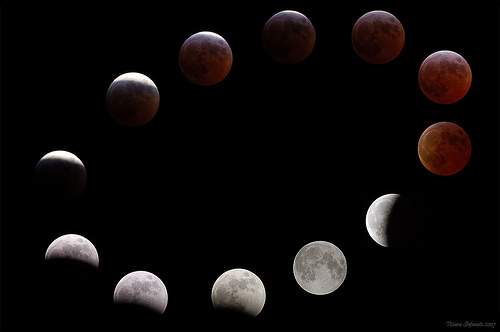
The phases of a lunar eclipse, by tizianoj at Flickr
A key tenet of biodynamics is the influence of celestial bodies (e.g., the sun, moon, and planets) on agriculture. While no one will deny the influence of the sun, it's not clear exactly what the moon might be doing to affect grapegrowing and winemaking.
Take the case of Aleš Kristančič of Movia in Slovenia. Thanks to glowing reviews and a high-profile section of Sergio Esposito's book Passon On the Vine, Movia has gained cult status for wine consumers. Kristančič is a very popular speaker around the world and is consulted often for his views on biodynamic winemaking. He makes a wine called "Lunar", farmed with biodynamic methods and bottled on the full moon. His explanation:
Flying stones. The "minerals" in the wine, which are somehow visible under a microscope, are lifted from the sediment by the gravitational force of the moon. It's not uncommon to hear biodynamic winemakers reference lunar cycles when deciding when to rack or bottle wine.
The Nature of Gravity
I think it might be prudent here to clear up some misconceptions about gravity. The force of gravity causes any two objects that have mass to accelerate towards each other. While its presence on Earth is obvious, gravity is actually the weakest of the fundamental forces, about 10-37 times weaker than the electromagnetic force, for example. It also gets weaker with the square of the distance (i.e., objects twice as far away will exert four times less gravitational force on one another). The earth is so massive, though, that when it attracts your face to the pavement, it still hurts like heck.
As I mentioned, everything with mass has gravity. The nearest massive object with enough mass to have non-negligible gravity is, of course, the Moon. The Moon is approximately 1/80th the mass of Earth (which is still pretty massive), but it is also about 220,000 miles away from us. However, the effect of the Moon's gravity is still evident in the rising and falling of ocean tides.
Fit to be tide?
It's a common belief that human behavior is affected by the moon.
Proponents of such a theory would argue that the moon's effect on tides
is due to an affinity for water and that humans are about 60% water, so
there must be an effect. However, despite the repeated anecdotal
assertions of emergency room personnel and police, incidences
of trauma and traffic accidents, there is no convincing evidence that any such events correlate with lunar cycles.
Gravitationally speaking, there's really no difference between the new moon and the full moon. In both cases, the sun and moon are aligned, contributing the largest total gravitational pull (even though the Sun's is about 50% of the Moon's). For all intents and purposes, the gravitational effect of the moon on the Earth is identical on the new moon and on the full moon.
Tidal changes in the ocean are observed (1) because the ocean is enormous and (2) because solid material, while affected by the gravitational force in the same way, does not get pulled around in a significant way. Indeed, the Earth's crust is affected by the Moon's gravitational pull, just not enough to be noticeable.
Let's put some numbers behind this. The acceleration due to the gravity of the moon (at the perigee, when the moon is closest to the earth) is approximately 1.34 x 10-7 times g the Earth's gravitational acceleration. The force generated by the moon that opposes the Earth's gravity is one ten-millionth the force of the gravity of Earth.
To put this into perspective, the gravitational acceleration in New York City vs. Los Angeles differs by about 0.06%, which is about 6,000 times more than the tidal difference in gravity.
Gravity affects every object with mass, not just water. And it certainly doesn't discriminate between "minerals" and other sediment. Will your wine settle differently in LA than in NY? Yes, but the moon will have very little to do with it.
As for racking and bottling, while there may be a slightly different gravitational effect on a quarter moon (neap tide) than a full or new moon (spring tide), is it more likely that this infinitesimal effect will change the sedimentation profile of the wine, or that it will be affected by flow or shape of the tank or bumping of the lees with the racking wand or seismic disturbances or any other more terrestrial factors?
To rephrase an old adage, wines housed in a glass don't throw stones.
Further reading
M Sawicki, "Myths about Gravity and Tides," originally published in The Physics Teacher, 1999.
SO Lilienfeld and H Arkowitz, "Lunacy and the Full Moon", Scientific American, 2009
DA Thompson, SL Adams, "The full moon and ED patient volumes: Unearthing a myth", The American Journal of Emergency Medicine, 1996.
